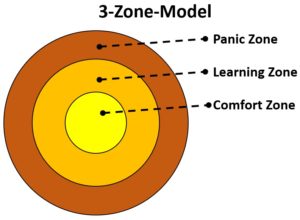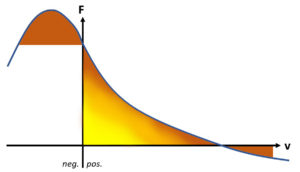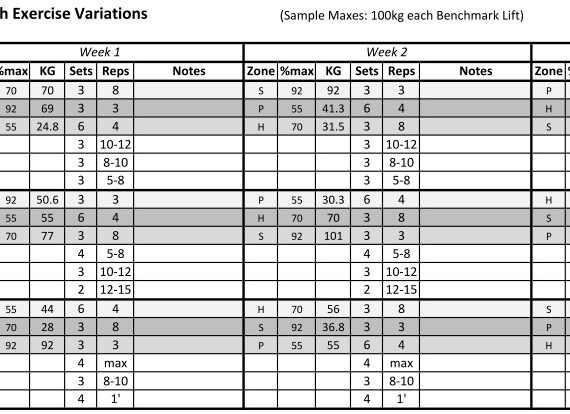In psychology there exists a 3-zone-model that should represent the different zones life happens. First there is the Comfort Zone, where a person is safe and can solve the given tasks with high competence. Routines, habits, and self-confidence mark important traits of this zone as well as low risk of failure. The second is the Learning Zone, often also called Growth Zone or Risk Zone. As the name already implies a person that leaves the comfort zone is confronted with novelty but gets rewarded with learning. The new challenges force us to take and manage some risk and if we overcome the challenge, we increase our competency and therefore expand the comfort zone. The third zone, the Panic Zone, is an environment that is hostile and highly stressful. It places excessive demands on a person but if the situation is mastered it gives a great sense of achievement. Imagine it like that: Singing in the Shower: Comfort Zone, Sober Karaoke: Learning Zone, Singing the anthem at the Super Bowl: Pretty sure Panic Zone, at least for most of us.
The Comfort Zone is tricky, because it gives us safety and as the name implies, comfort: Outside of this zone there is mostly danger and fear: We easily let ourselves be lulled into an illusion of security and control and don’t recognize that we stop to live and develop. Life begins at the end of the Comfort Zone: Personal, mental, and physical growth needs new stimuli that you only in the Learning Zone or beyond.
But what does this have to do with training or more specifically with the Force Velocity Curve? As everything in life, also our body needs stimuli to adapt to, to improve performance: Systematic training is a planned way to consistently put ourselves out of the Comfort Zone and, over time, bring us closer to the set training goal. Adaptation is followed only by a high enough training stimulus, found in the Learning Zone of even further but not in the Comfort Zone. To put some sayings together: The Comfort Zone is where dreams go to die, in the Learning Zone progress is made and the Panic Zone is where the magic happens!
 Speaking “training” we could look at the Force-Velocity Curve and find the different zones: The most extreme Comfort Zone is obvious: Where the X- and Y-Axis intersect there is Zero Force and Zero Velocity, aka lying on the floor. Not exactly what we call training isn’t it? The Other extreme is way more interesting: Panic Zone Training! We find that kind of training close to, or over the intersection points of the F-V-Curve with the axes. If we either train close to the poles of maximal force (close to 1RM or with Eccentric Overload) or to maximal Velocity (close to Max Speed or Overspeed) we will have great discomfort and the highest neuronal demand, but we can also have great training effects. The high demands make it difficult to sustain over prolonged phases and needs careful planning with appropriate recovery, but it definitely has its place in a high-performance training. The Learning Zone on the other hand is where probably for most the majority of training happens: Somewhere in the middle, where the stimulus is high enough to trigger adaptation but not so high that the next training is heavily impacted.
Speaking “training” we could look at the Force-Velocity Curve and find the different zones: The most extreme Comfort Zone is obvious: Where the X- and Y-Axis intersect there is Zero Force and Zero Velocity, aka lying on the floor. Not exactly what we call training isn’t it? The Other extreme is way more interesting: Panic Zone Training! We find that kind of training close to, or over the intersection points of the F-V-Curve with the axes. If we either train close to the poles of maximal force (close to 1RM or with Eccentric Overload) or to maximal Velocity (close to Max Speed or Overspeed) we will have great discomfort and the highest neuronal demand, but we can also have great training effects. The high demands make it difficult to sustain over prolonged phases and needs careful planning with appropriate recovery, but it definitely has its place in a high-performance training. The Learning Zone on the other hand is where probably for most the majority of training happens: Somewhere in the middle, where the stimulus is high enough to trigger adaptation but not so high that the next training is heavily impacted.
As often when it comes to “zones” in training, it is difficult to draw clear lines, what makes this idea a rather theoretical construct. Still it might be helpful to think about the zone one is training or prescribing training in: Ditch the Comfort Zone, Exploit the Learning Zone and use the Panic Zone carefully and wisely.

